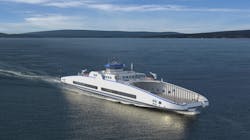Pioneering Electric Ferries to Ply Waters of Great Lake
Damen Shipyards Group, which has built two electric ferries for the Ontario Ministry of Transportation, has selected energy storage firm Leclanché to construct a pair of fast-charge eFerry stations on Canada’s Lake Ontario.
Leclanché supplied the battery systems that power Damen’s new Amherst Islander II and Wolfe Island IV eFerries. It will install the eFerry stations on a turnkey basis at docks on the mainland in Millhaven, Ontario, and on nearby Amherst Island at Stella, Ontario – all located in the northeastern corner of the Great Lake near Kingston, Ontario.
“Damen’s broad range of ultra-modern ferries operate all over the world and we’re proud to have partnered with Leclanché to build two state-of-the-art all electric ferries which are a first-of-its-kind for North America and a breakthrough in sustainability,” commented Leo Postma, Americas sales director with Damen. “This partnership is consistent with our goal of being the world’s most sustainable shipbuilder. Extending our partnership for the on-shore fast charge and electrical storage system is a natural outgrowth of our business relationship and consistent with our pioneering role in the maritime energy transition. It also provides many benefits to Ontario’s Ministry of Transportation.”
The Bureau Veritas-certified eFerries, which completed sea trials on the Black Sea in April in May of this year and will be transported to Canada via a specialized semi-submersible vessel, include:
- Amherst Islander II (Damen 6819 E3): Linking Millhaven and Stella, this fully electric vessel uses a 1.9-megawatt-hour (MWh) capacity battery system and produces zero emissions. It will carry up to 42 cars and 300 passengers at speeds up to 12 knots.
- Wolfe Islander IV (Damen 9819 E3): This eFerry will connect Kingston and Wolfe Island and uses a 4.6-MWh battery system. It can carry 83 passenger vehicles and 399 passengers, produces zero emissions, and will sail at up to 12 knots per hour.
“We’ve all observed the growing pains of the global electric automotive industry and the barriers to mass adoption caused by the lack of public and universal charging infrastructure,” said Leclanché CEO Anil Srivastava. “You can’t have eFerries or electric trains, buses, trucks, or other modes of transportation displace fossil-fueled modes of transportation without a reliable, cost-effective, and energy-efficient infrastructure in place. Our new zero emission ports and harbors solution architecture will make it easier for ship designers and port authorities to design, built, and welcome to their shores the latest generation of sustainable vessels.”
The Ontario ports and harbor systems will use a 3-MWh Leclanché battery energy storage system (BESS) in port-side structures – one BESS in Milhaven and another in Stella. Leclanché noted the BESS, charged by the harbor grid, will be connected to the ferry charger with 1800-kilowatt DC-DC converters. The company explained the “buffer stations” will integrate a fire suppression system in which pipe-in water runs alongside the battery racks and behind each battery module.
Leclanché stated the crossing time between ports will be 20 minutes, adding that its high-power, DC-to-DC charging system will “refuel” an eFerry in 10 minutes at each port. The company added the batteries have been designed to charge each vessel up to 7,850 times per year over a projected 10-year lifespan, with a daily duty of 21 hours regardless of weather conditions.
“Our continuing partnership with Damen is bringing several firsts to market including the first fully electric passenger and car ferries in North America and the first time two of our business units have collaborated to create an end-to-end solution for a key customer,” concluded Srivastava. “Now, thanks to our e-Marine and Stationary Solutions teams, passengers will be able to embark on a vessel powered by Leclanché technology onboard and recharged on shore – with the added benefit of our electrical storage systems providing stability to the local power grid.”







